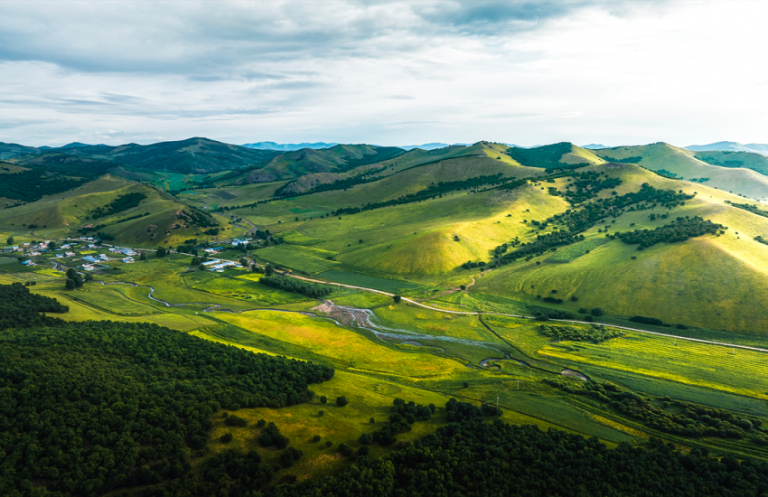
By Wu Yue, “Liang, where are you going, ” asked a villager in Xikou village, Mingshuihe township, Arxan of Hinggan League, north China’s Inner Mongolia autonomous region.
“I have a guest, so I’m showing him around the village,” Liang Shusen answered.
Today, Xikou village has become more and more enriched with cultural landscapes – a cultural square covered by artistic works, sculptures scattered among the woods on hills, and an art gallery turned from an old village office where photography exhibitions are often held.
This artistic atmosphere has been created thanks to some teachers and students from the Academy of Arts and Design, Tsinghua University (AADTHU).
An art fair was previously held in Xikou village. The chief curator of the event and dean of the AADTHU Ma Sai told People’s Daily that as one of the organizers of the event, the academy has taken over 200 teachers and students in more than 10 batches to Xikou village for artistic exploration since September 2022.
Last summer, Xikou Village teamed up with several artists from art schools and design institutions to carry out art creations in the small mountain village. Through creative collaborations, the village has been infused with new artistic charm.
“This work is called ‘Fish Every Year’ and we participated in its creation,” said Dong Yali, head of a willow weaving workshop in Xikou village, referring to a group of “fish” weaved with curved willow branches. The work has the best wish of “may there be surpluses every year,” because the Chinese word for fish is a homophone of the word for surplus.
When the LED light strips on the creation are illuminated in the night, it looks as if the fish are swimming in the sky.
Having been engaged in willow weaving for over 30 years, Dong had never imagined that one day she would collaborate with students and teachers from the AADTHU.
“In the past, most of what we made were daily necessities and decorations. Now, willow branches have become art pieces. It’s especially fulfilling to introduce them to tourists,” she said.
The main designer of “Fish Every Year” is Professor Lin Lecheng at the AADTHU. Engaged in fiber art research and design, Lin became interested in the willow branches when he first visited Xikou village.
Therefore, his team then used local materials and collaborated with the villagers to create the artwork. The exhibition label on the side of “Fish Every Year” lists the names of the 12 villagers who participated in its creation.
In Lin’s view, art is vitalized when it comes to the countryside. The vast rural areas provide fertile ground for creativity and offer ample space for artistic works.
Kong Fandi, who graduated from the AADTHU, was born in the 1990s and grew up in the city. Last year, he made several trips to Xikou village.
He was inspired by the firewood sticks used by the villagers, so he started making art pieces with them. “Wood comes from the forest, and I want to ‘move’ them back to the forest,” he said.
Kong collected unused wood from the villagers and stacked it naturally and artistically with different colors. Together with nine villagers, he created an artwork called “Waves of Forests,” which shines like a rainbow in the forest.
The villagers participated in the creation by fixing the wood and painting. They also documented the process through short videos on social media.
“Some villagers said they want to transform their homes into B&B hotels for tourists to enjoy the scenery. I think this is a manifestation of art empowering rural areas,” Kong said.
In Xikou village, the artistic works bear the imprint of villagers’ participation, and many of the villagers can explain the connotation behind the artworks to visitors. The village brings inspiration to art creation, and the vibrancy of art also permeates the lives of the villagers.
Villager Su Lihong has placed vibrant bouquets in front of her family restaurant, which makes the restaurant more lively.
“These decorations were done by my family – after seeing other people’s artworks, I also wanted to give it a try,” Su said.
“The village is becoming more beautiful, and more and more tourists are coming here. As a result, our restaurant’s business has also improved,” she added.
Shang Yan, the owner of an inn in Xikou village, held a T-shirt designed by students and teachers from the AADTHU, hoping to have each creator sign their name on it.
“The students staying at our inn have such amazing design works, and I would love to collect a few pieces. In the summer of 2023, we had more guests staying at our inn, and our income increased by 1/3 compared to the same period the previous year,” said Shang.
It is reported that Xikou village is a key village for rural tourism in China. During an art season in 2023, the village saw approximately 8,000 visits, with tourism revenue exceeding 2 million yuan ($281,611).
The students from the AADTHU are also looking forward to returning to Xikou village. Undergraduate student Sun Qian and her classmates completed an artwork, making swallows out of colorful acrylic panels to express the fond memories and dreams of the wanderers for their hometown.
This experience made her have deeper reflections on comprehensive rural revitalization. “I hope that with the development of rural areas, more young people will return like swallows.”










